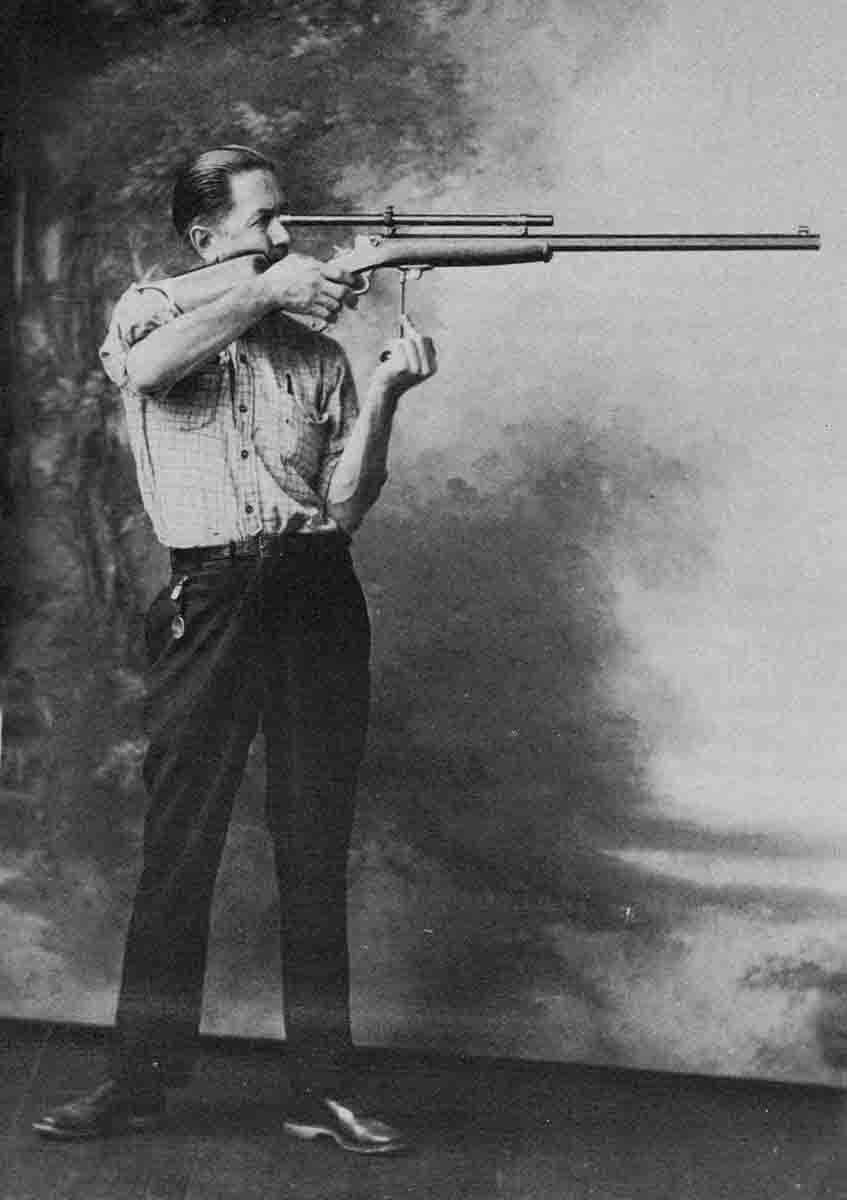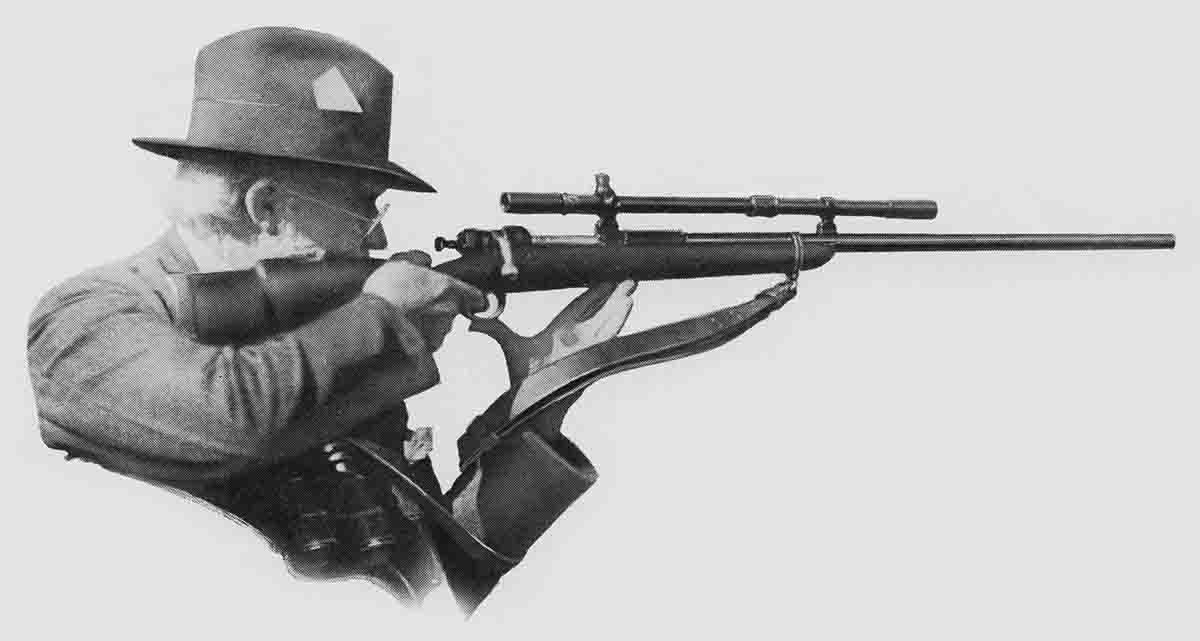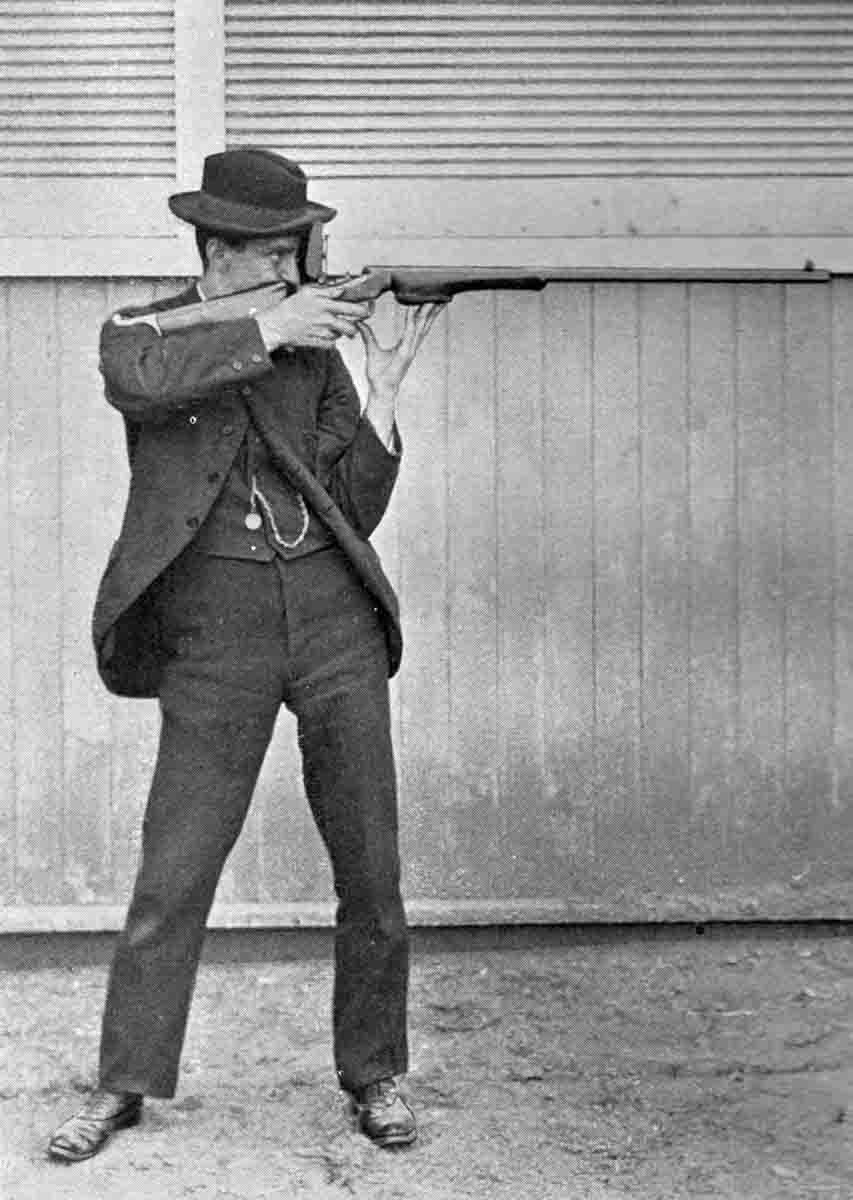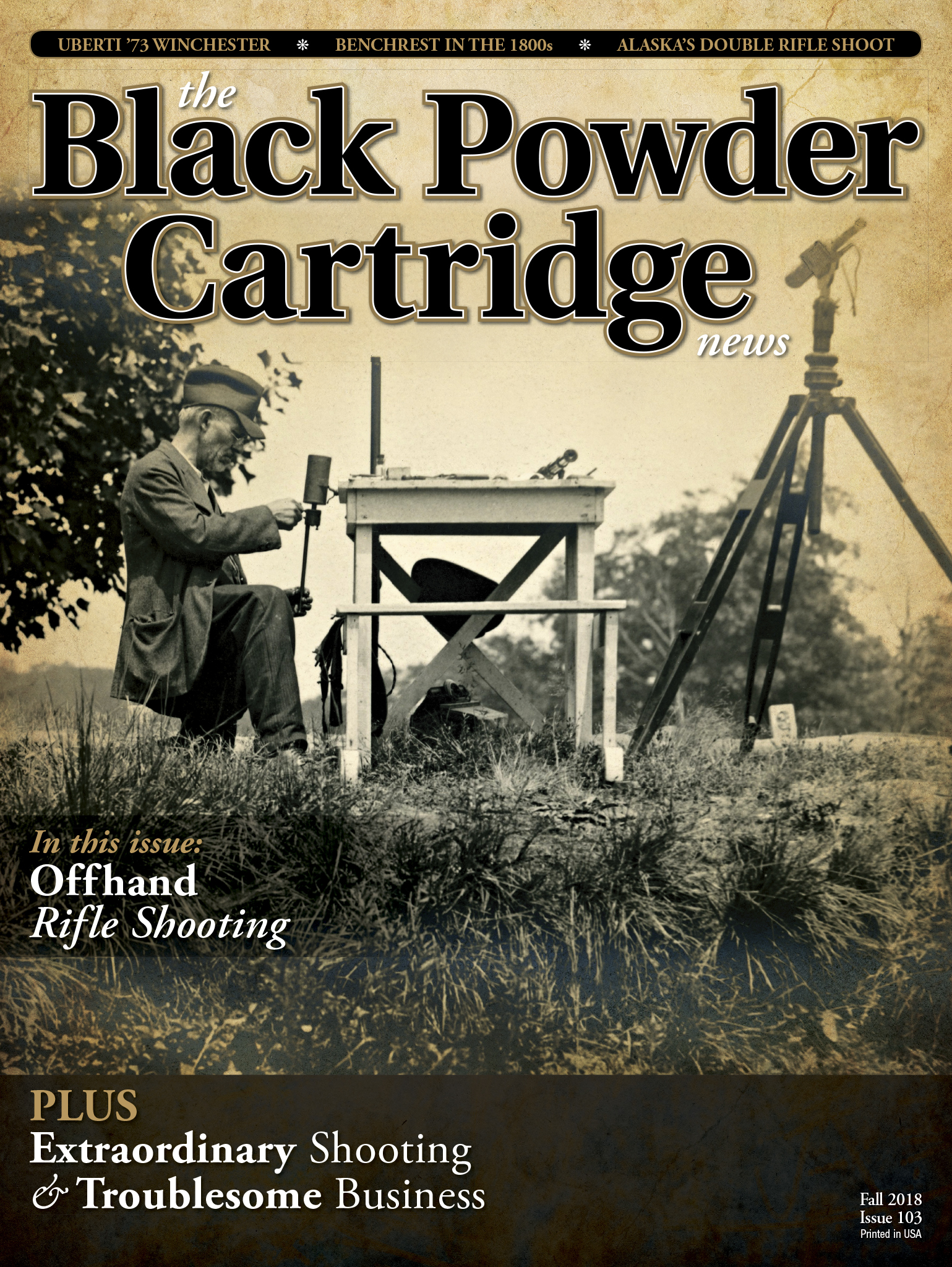Offhand Rifle Shooting
feature By: H.M. Pope | October, 18
This extremely informative article on offhand shooting was forwarded to us by good friend and BPC News contributor, Leo Remiger. It was written by famous barrel maker and Schuetzen competitor, Harry Pope. First published in the periodical Arms and the Man (July 1, 1922), it is as relevant now as it was then. When he was in his prime, Pope’s offhand shooting ranked among the best in the world. Those wishing to improve their offhand scores will seriously consider these wise words. – Steve Garbe

Personally, I think that last year’s victory, without prejudice to anyone, was not a victory of the team but a victory of the sling strap. Rumor has it that this year the foreign teams will be as well equipped in this respect as our own and also well practiced in its use. The general use by our opponents of smaller calibre rifles, with less recoil, will be a decided advantage in their favor, and it behooves us to get busy and improve our scores in our weakest position, offhand shooting.
I hope that the following, largely based upon my own many years’ shooting and many years’ association with the best offhand shooters that this country has ever produced, as well as my long experiences in rifle making, may help others, not only to places on the team, but to ultimate victory. As these matches will be shot with a fully equipped heavy target rifle, the most of this article will be devoted to that arm.
The Palm Rest
This is by no means the contemptible toy that most shooters imagine, but to most men a very useful article – an equalizer of men’s physical peculiarities and differences.

The very first thing to do on a strange range is to properly adjust the palm rest for length, endeavoring to shoot from one shooting stand only so that the various uneven footing will not effect the elevation of the rifle.
To do this one must stand at the firing point where one is to shoot, in a perfectly natural easy position, directing the rifle toward the target. Close your eyes as you settle into a perfectly natural position, then open the eyes, and the sights should point level with the bull’s-eye, without the shooter having to bend the body either forward or back; if it does not, change the length of the palm rest until it comes just right.
The proper position of the palm rest is important. It should be neither too close to the receiver nor too far away. If too close, the left hand has to support too much weight; also movements of the holding arm move the muzzle too rapidly. In other words, the control is bad; also the excessive weight tires one sooner. It must not be forgotten that the weight that the left hand is holding is generally considerably in excess of the rifle itself, due to the center of gravity of the rifle being outside the support.
The writer’s favorite offhand rifle has a heavy barrel, 32 inches long, and a light stock-weight, as excess weight in the stock is useless. It is 48 inches from the hollow of the butt plate to the muzzle; the palm rest stem is 20 inches from the hollow of the aluminum butt plate. The weight of the rifle is 13 pounds. The weight on the palm rest in holding is 143⁄4 pounds. If the palm rest is moved back two inches it increases the holding weight to 18 pounds, closer yet runs the weight up very rapidly.
Twenty inches from the butt plate would place the stem of the palm rest about ½-inch ahead of forward part of the metal trigger guard of the Springfield rifle with standard stock. If the palm rest is too far forward, the weight of the rifle tends to force the palm rest open and away from the body. It should be so that the weight should tend to close it together, without pull of the arm toward the body. The palm rest should not rest in the palm but on the heel of the hand, so as to avoid the flexibility of the palm and its muscular movements; in short, the rest and forearm in proper relation to one another is a direct strut from the rifle to the hip without any muscular change of length. The left hand should be in a perfectly natural position, and the fingers lightly closed on the knob.
Position
This again will vary somewhat with individuals, but it must be perfectly natural, easy and free from muscular strain. The weight should be about evenly distributed on both legs, which should both be straightened out and not too far apart, as this means muscular strain, while the bones should carry the weight. As the writer stands, the feet are at an angle of about 60 degrees, the left foot about 50 degrees with the line of fire, the right a little back or square to the line of fire, the heels 7 inches apart. Don’t straddle.

A little practice lets one get set at the proper angle, so very little of this setting is necessary; but do so if much off.
Aiming and Pulling
In a match of considerable length one should never try to pull every shot dead center. It can’t be done, and to try to do so only results in fatigue and wild shooting. No matter how expert, one practically never holds perfectly still; there is always a swing or tremor. Don’t out hold your wind. Try to pull the first time the sights swing slowly into a position that you can pull cleanly, to score slightly above your average score. In doing this you avoid wild shots, and many times you get off practically on center.
A good score is not made by a large number of perfect shots, but by the absence of poor ones. It does not pay to try to pull centers, unless nothing else will do in a tight place; then be careful. If the sights will not settle

The set trigger should not be extremely fine, but should be perfectly clean and without kick to the finger when it lets go. The trigger guard or lever should bring the trigger finger into such a position that the tip of the finger comes naturally just onto the trigger. This position you must learn to shoot well; the finger can not be away from the trigger when you want to pull, but in contact with it. The best way when aiming is to keep touching the trigger with the tip of the finger, then when the sight swings deep into the bull, a little harder touch lets it off. The object of doing this is to avoid sympathetic movements of the other fingers at the same time, which disturb the aim. It is very hard to make a quick movement of one finger without also moving the adjacent fingers more or less, which movement disturbs the aim.
In aiming the rifle, the left arm should be along the side, the elbow resting on the hip bone if you are so built; if not, then along the side of the short ribs – not in front over the heart and stomach, which cramps the breathing and heart action. The right arm should have the elbow well up, not against the side; this pulls the chest open and gives the lungs more capacity; it also allows the use of a straighter stock, and a rifle with a straight stock shoots more uniformly than one with much drop. Proper adjustment of the palm rest will allow this position.
Breathing
It is extremely important that you pay careful attention to this. One should breathe slowly and deeply. Do not allow yourself to breathe fast, as that tends to make the pulse rapid, which in turn affects the aim. If one is shooting continuous scores with fixed ammunition, one is apt to get short of breath before the score is finished and the pulse goes up. This is because the blood is robbed of the necessary oxygen when holding the breath. We compensate for this by deep slow breathing, making the whole surface of the lungs work instead of the small portion of the same in ordinary use. As I raise my rifle to aim, I lift it high and fill my lungs fully, as I begin to settle I breathe nearly empty, then as the aim begins to settle, breathe about half full and hold the breath till I fire; then at once begin breathing again deeply and slowly.
Weight
For the finest offhand shooting the rifle must be muzzle heavy. This is not, as most shooters suppose, wholly in the weight of the rifle, but is in the disposition of the weight. As much as possible should be in the barrel. Weight in the stock and butt plate is useless except in absorbing recoil. The use of a heavy butt plate is to be condemned. While it tends to balance the rifle when the same is carried free, its weight is entirely on the right shoulder in shooting and does not in any way change the weight supported by the left hand. In fact, the rifle at the shoulder is a second-class lever in which the power is the weight of the rifle concentrated at its center of gravity, which should be well outside of the palm rest. The fulcrum is the shoulder, and the work is the weight held in the left hand. If the center of gravity is in front of the palm rest, then the weight held in the left hand is greater than the rifle. If the center of gravity is inside the palm rest, the weight on the left hand is less than that of the rifle.
It is necessary to hold a reasonable amount of weight on the left hand in order that the swing of the rifle may be slow and give one time to pull. If the weight resting on the left hand is the same, no matter what the actual weight of the rifle itself, the effort to move it will be the same. It is possible to build a rifle to weigh 12 or 20 pounds and have it hold exactly the same. In other words, except to absorb recoil, the shooting weight of a rifle is not what the rifle actually is, but how that weight is distributed. Anyone can prove these facts for themselves, as I have done for many years to my customers, by simply holding the rifle by the butt plate so it will not overturn on a small platform scale, first weighing the rifle itself, then by supporting it at various places to see what the left hand actually holds, and not forgetting before you finish to tie a couple of pounds or so onto the butt plate in order to convince yourself that it has absolutely no effect on the weight held in the left hand, and therefore has no effect on the shooting balance of the rifle and no influence in slowing the movement of the muzzle in aiming.
Stock
This should be as straight as possible to conform with comfort. The cheek piece should be high enough so that when the eye is in line with the sight it presses firmly against the cheek, as this materially helps steady the rifle. The cheek piece if hollowed should have no projection in front, but a straight run, for the rifle recoils an appreciable amount before the bullet leaves the muzzle, and any projection rolls the rifle as it drives back and roll will vary with uneven holds; consequently the bullet direction also varies and you get shots where you do not expect them. It is very important that the butt stock should be tight. A loose butt stock will scatter the shots badly; so also will anything else loose, though to a less extent.
Practice makes perfect. Get all you can. Carefully note everything that you do, and you will find your work improving.
Good luck be with you.


